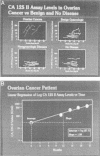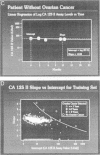Abstract
Elimination of cancer in the 21st Century is likely to depend not only on more effective individualized treatment, but also upon earlier detection and prevention of different malignancies. Screening strategies for ovarian cancer have centered on the serum tumor marker CA 125, transvaginal sonography (TVS), or sequential use of the two modalities. A single determination of CA 125 is neither sufficiently sensitive nor specific to be used as an initial stage in screening. Specificity can be improved by monitoring CA 125 over time with an algorithm that estimates risk of ovarian cancer. Sensitivity of CA125 can be improved by use of multiple markers in combination. Gene expression array analysis, proteomics and lipomics are being utilized to identify markers that can be used in combination with CA 125 to detect >95% of early stage ovarian cancers. To maintain high specificity, values for different markers are being combined using novel approaches of neural network analysis and mixed multivariate analysis. Sequential use of multiple markers and TVS could provide a cost-effective strategy to detect a disease of intermediate prevalence.
Full text
PDF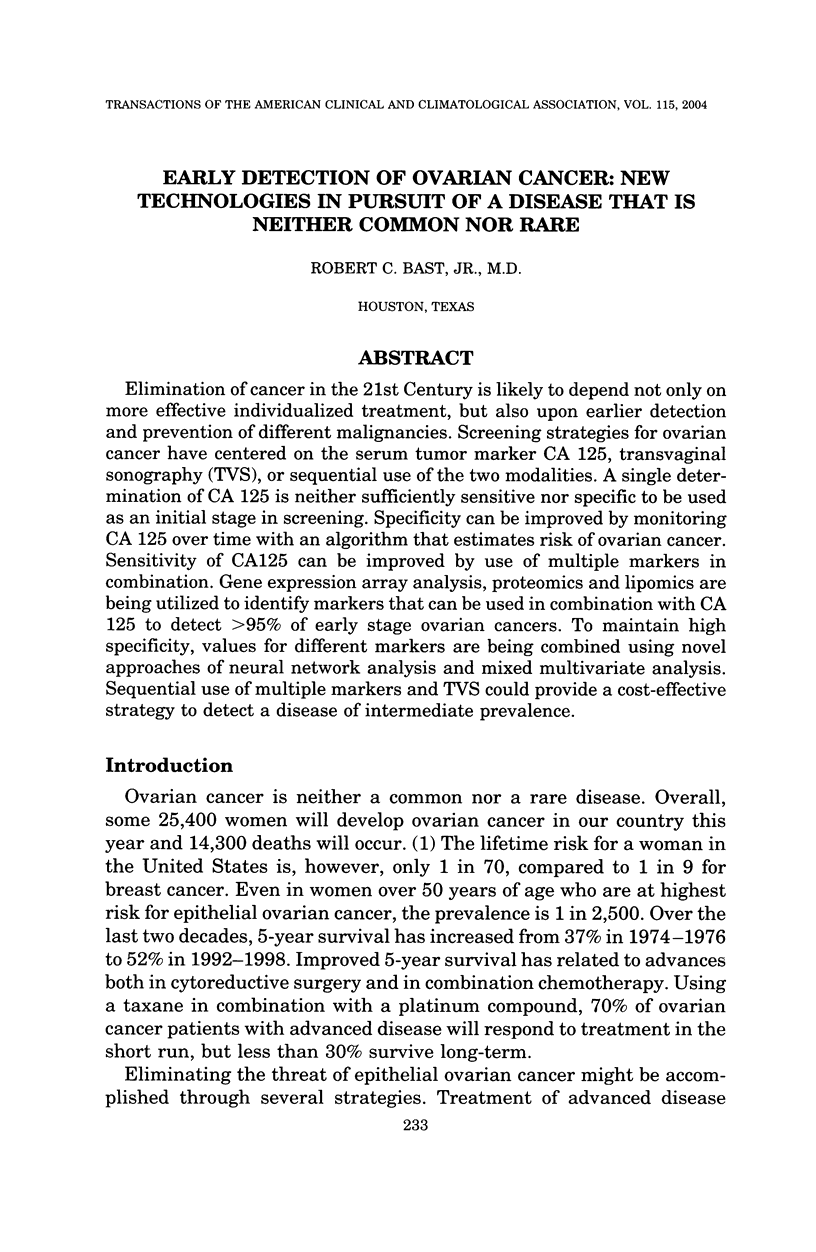
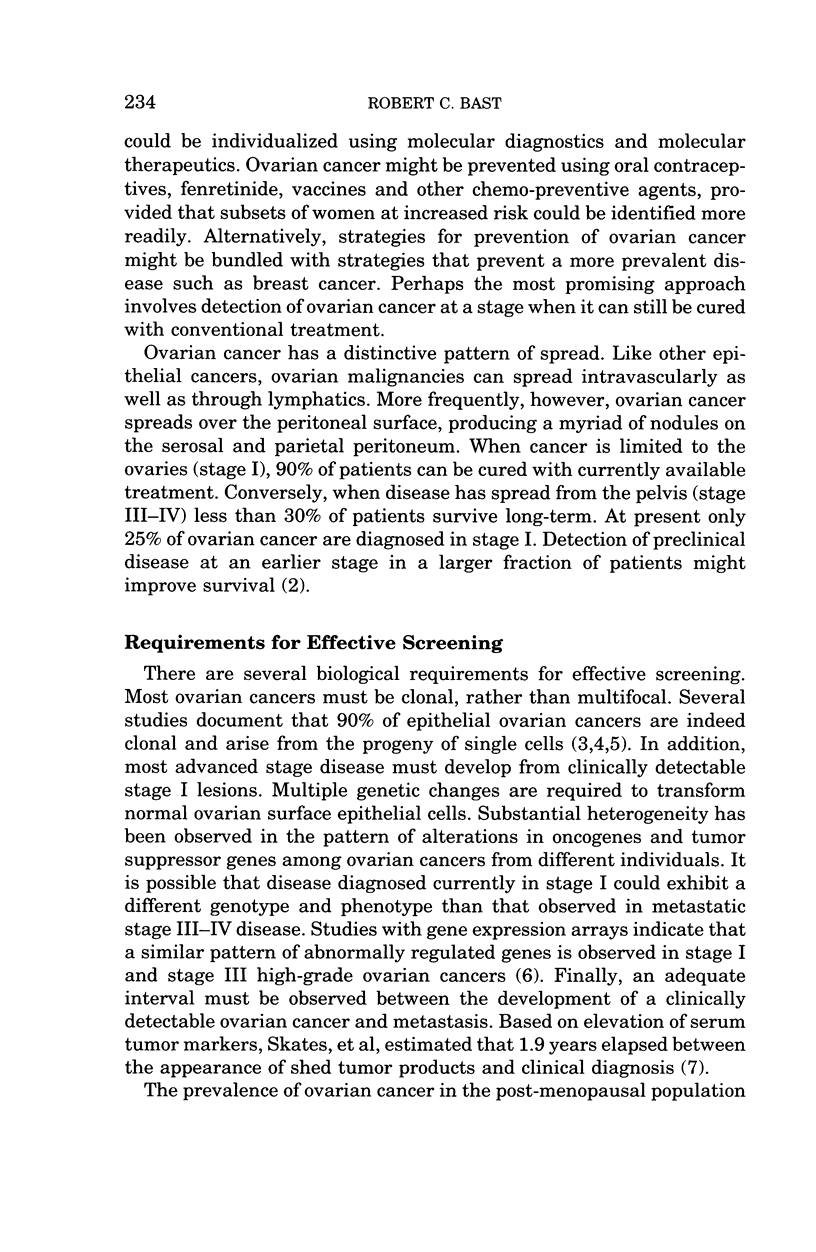
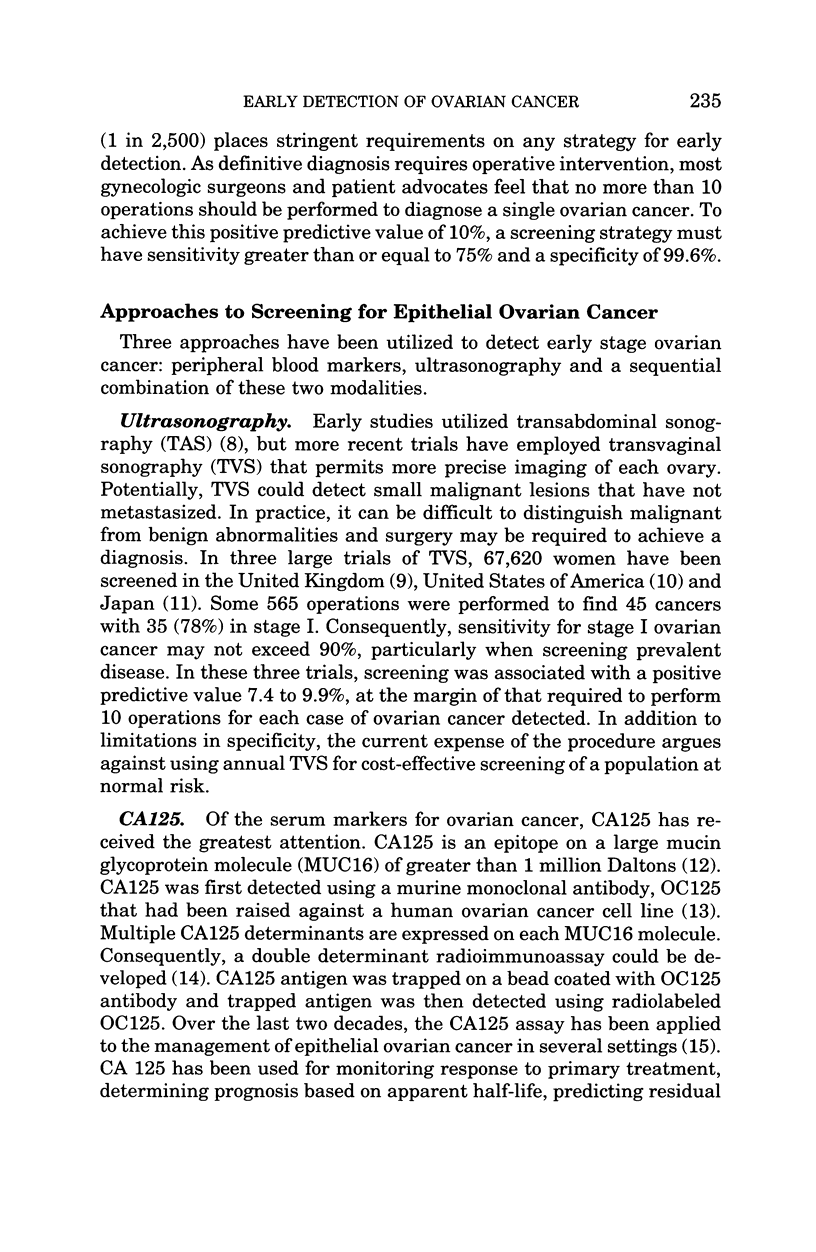
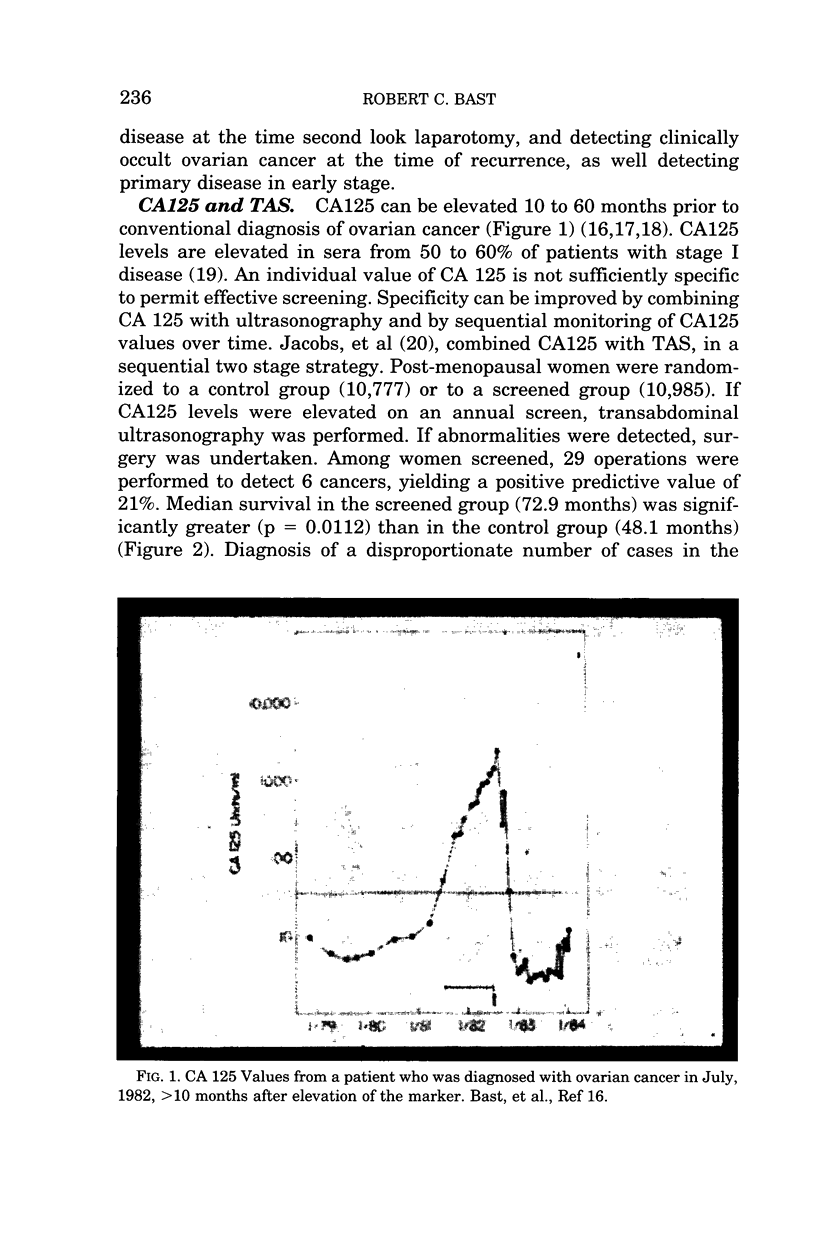
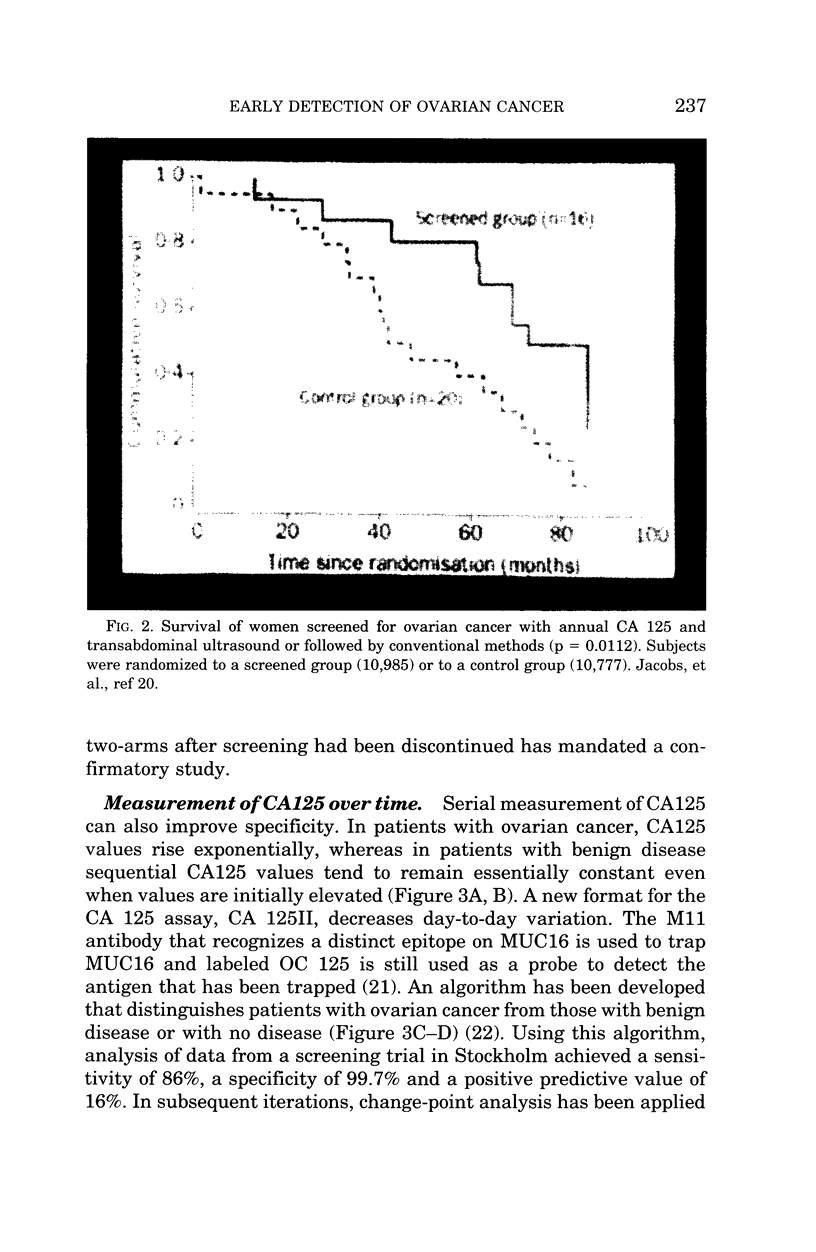
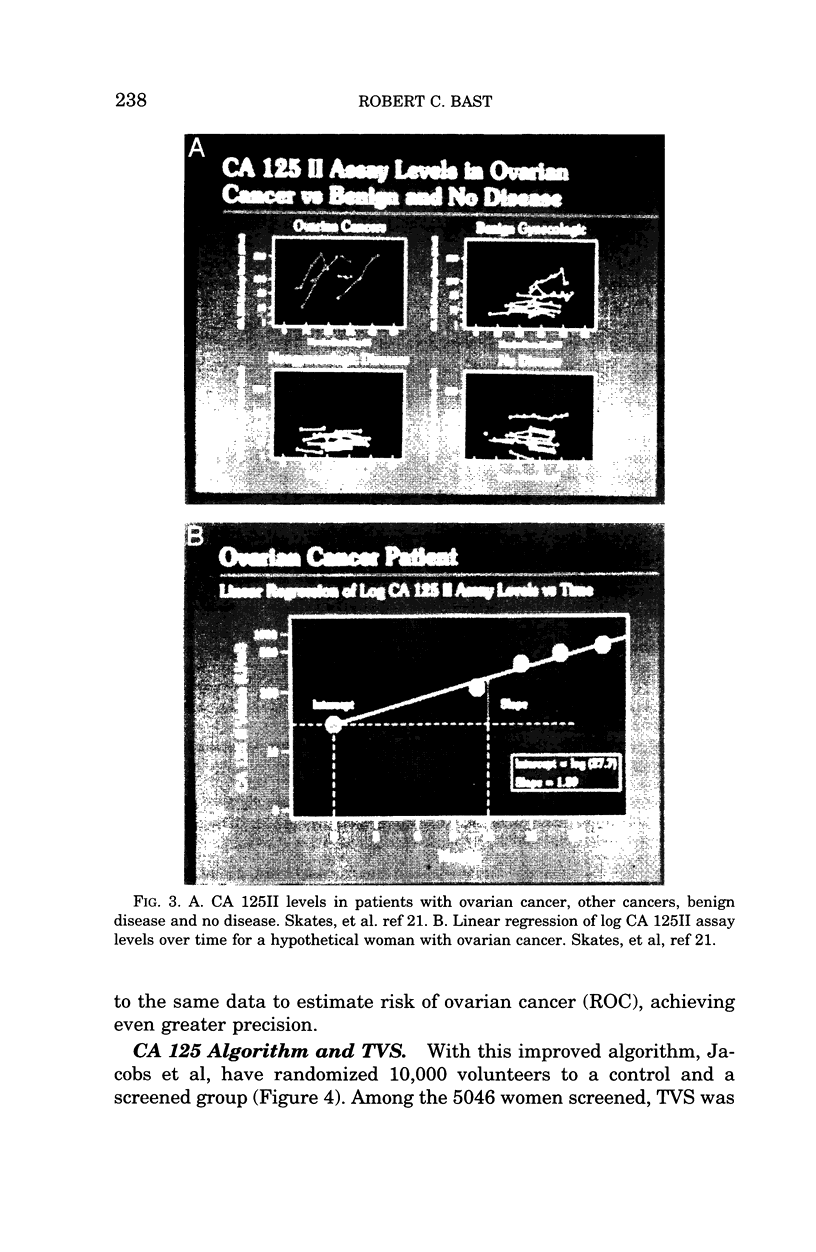
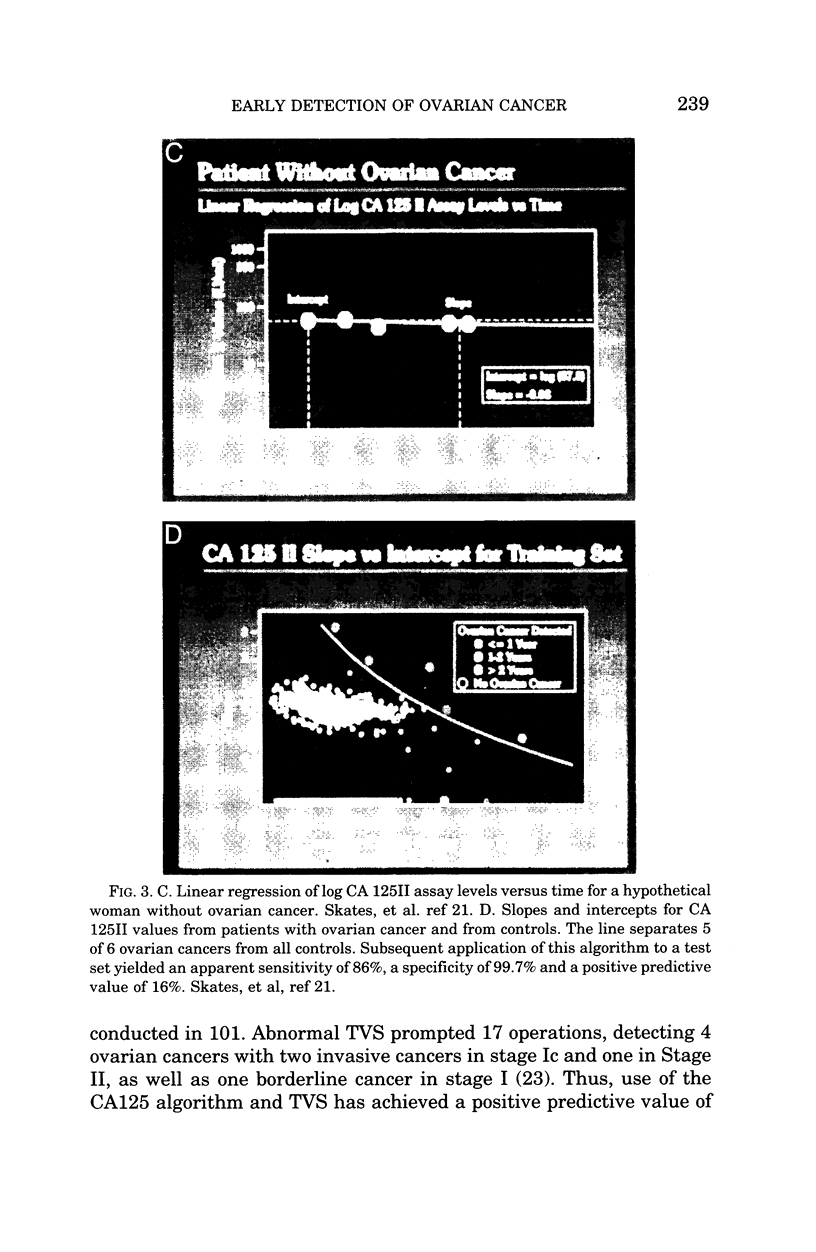
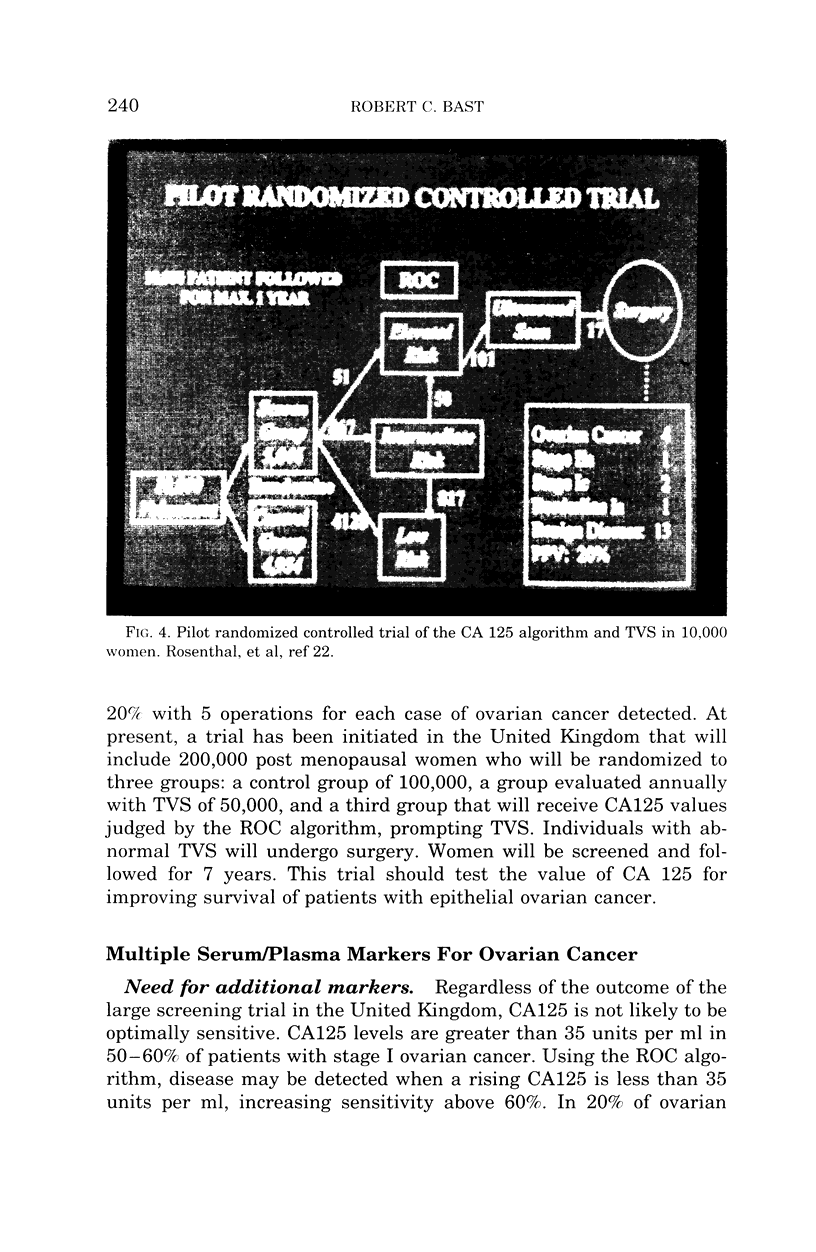
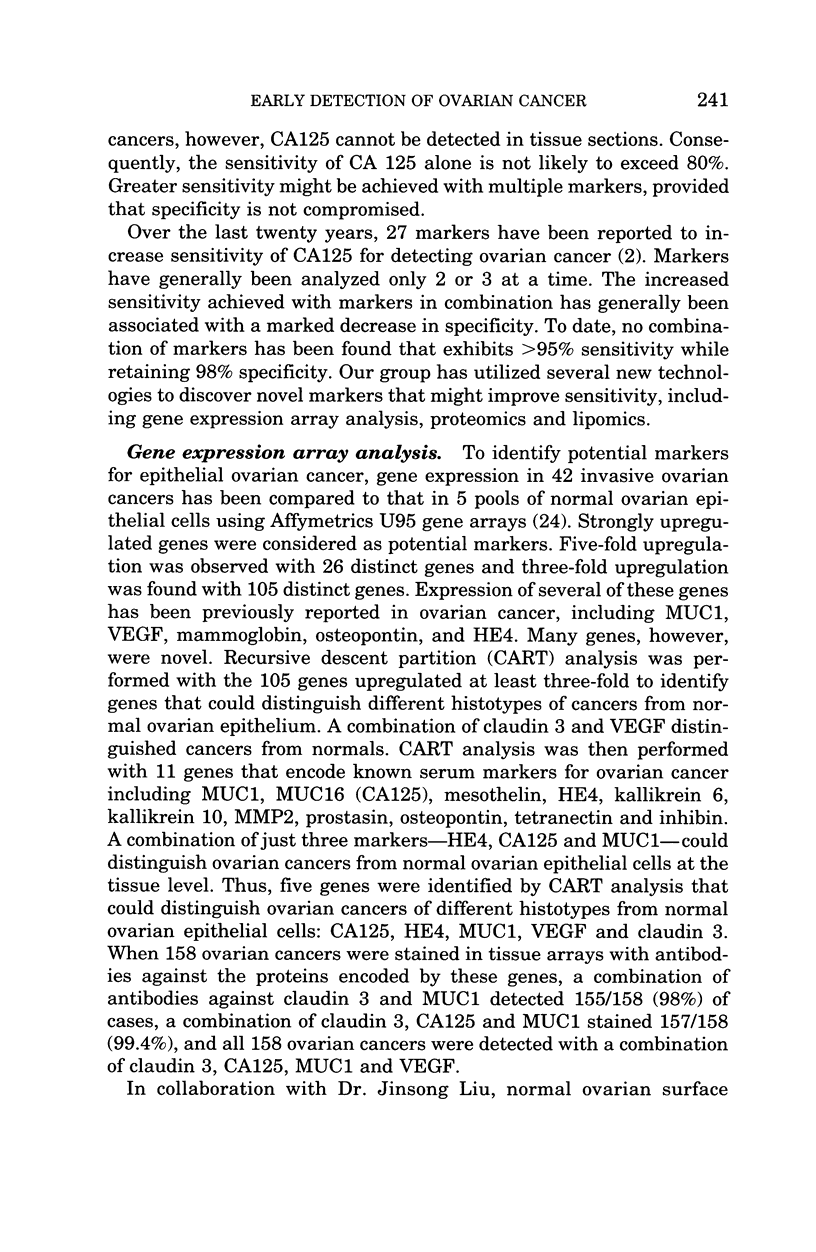
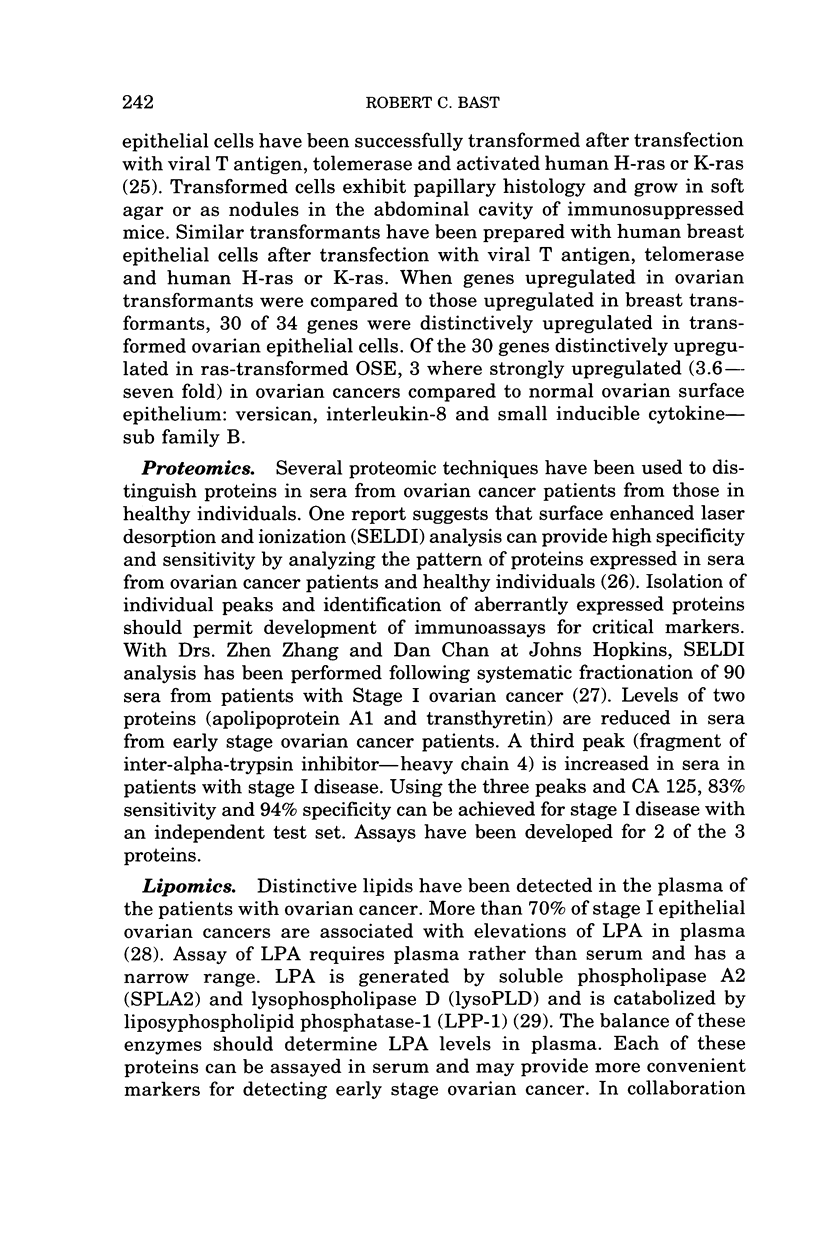
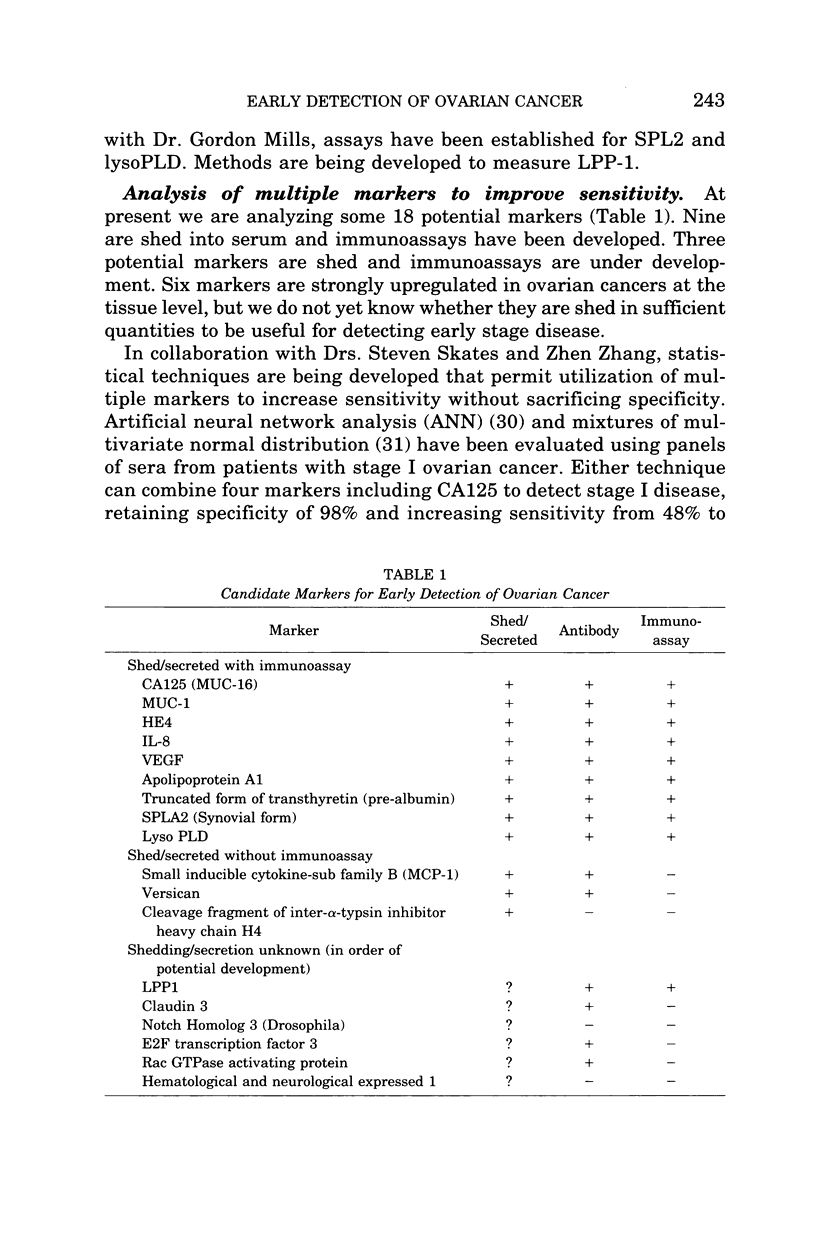
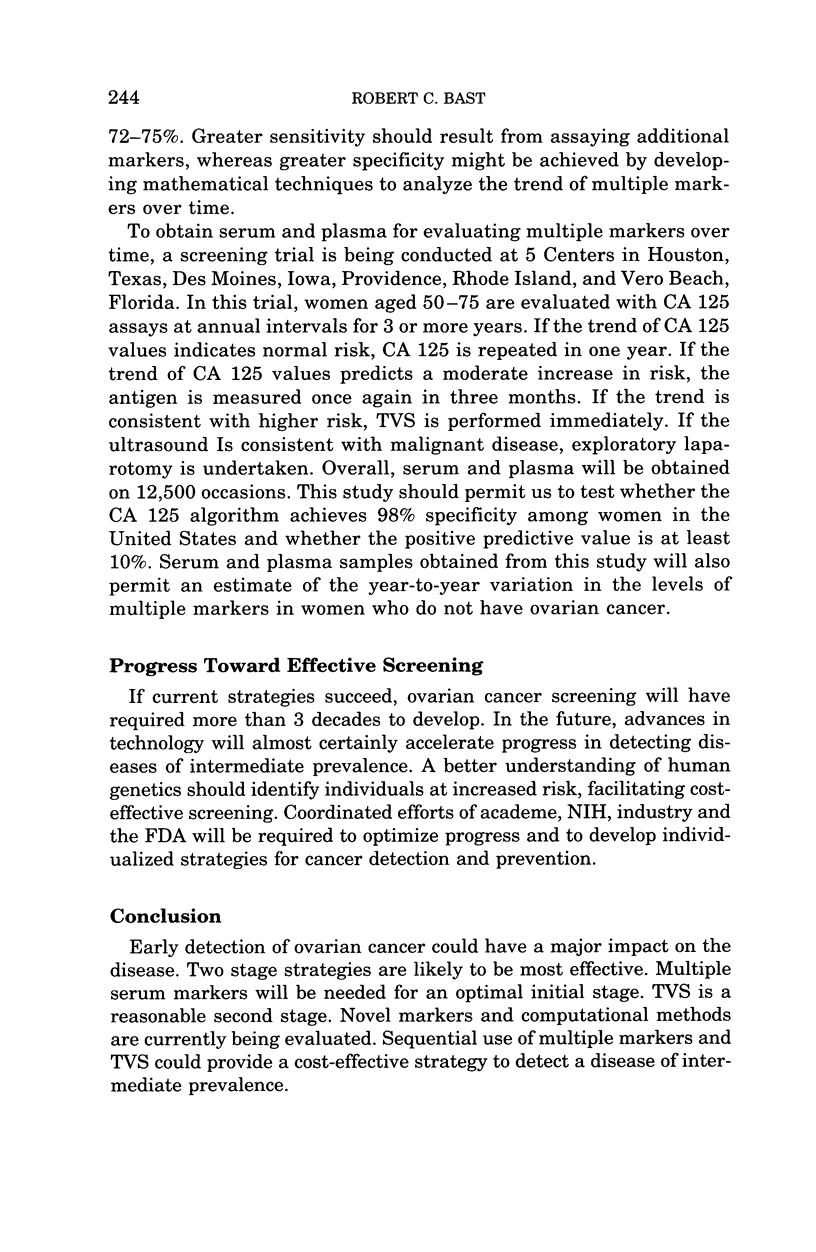
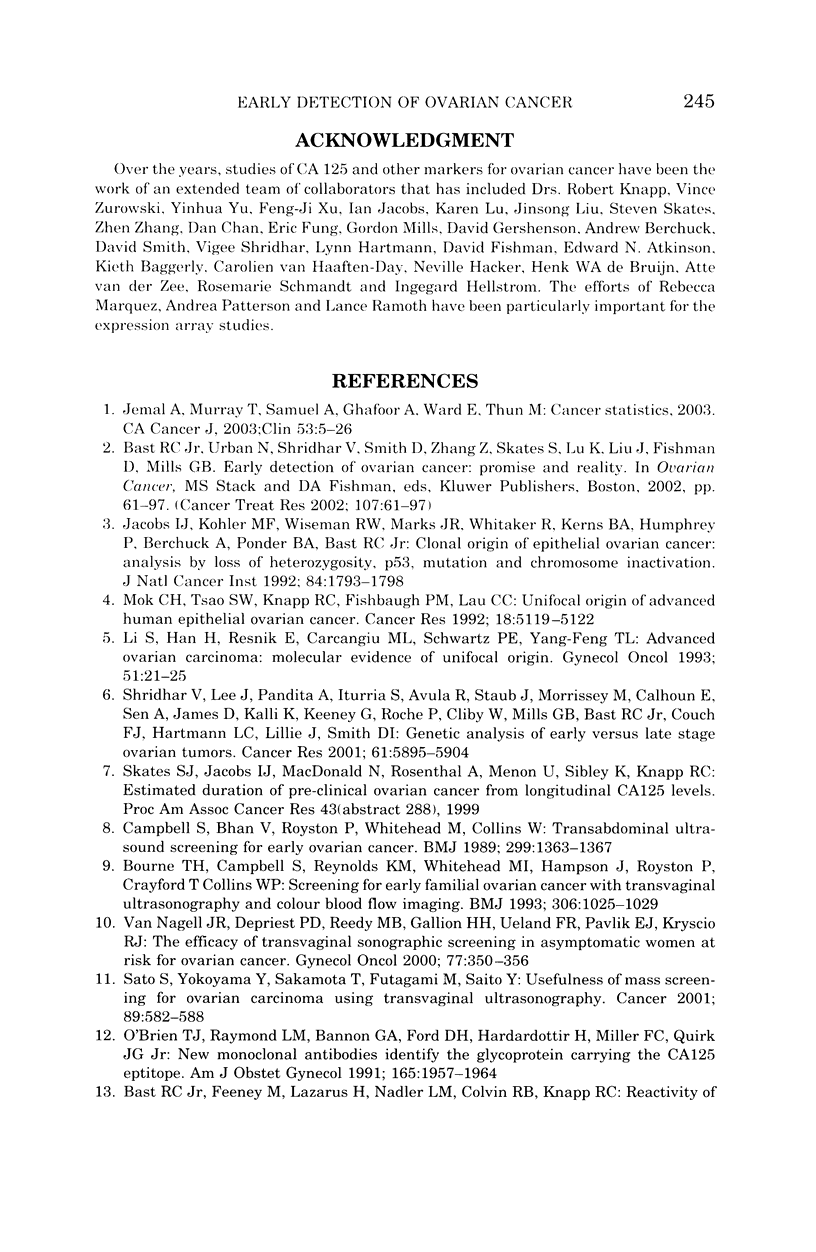
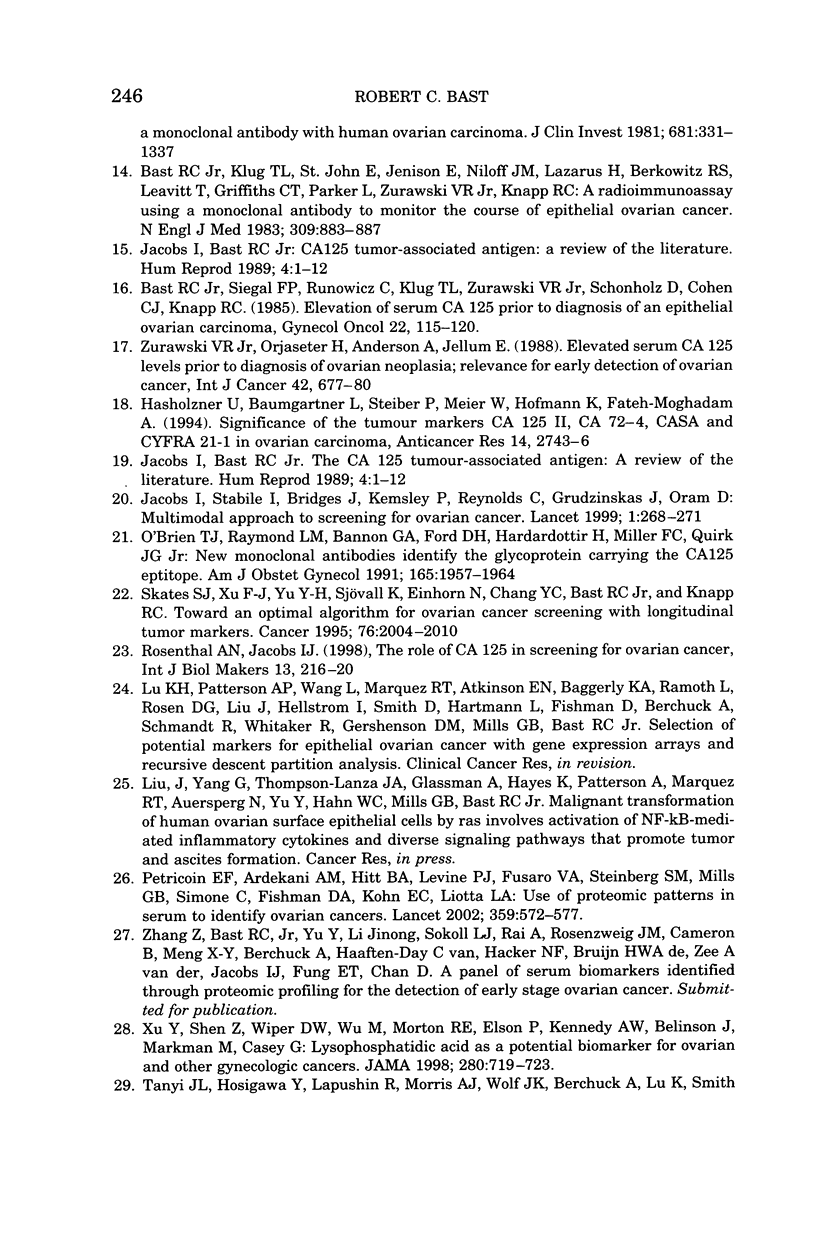
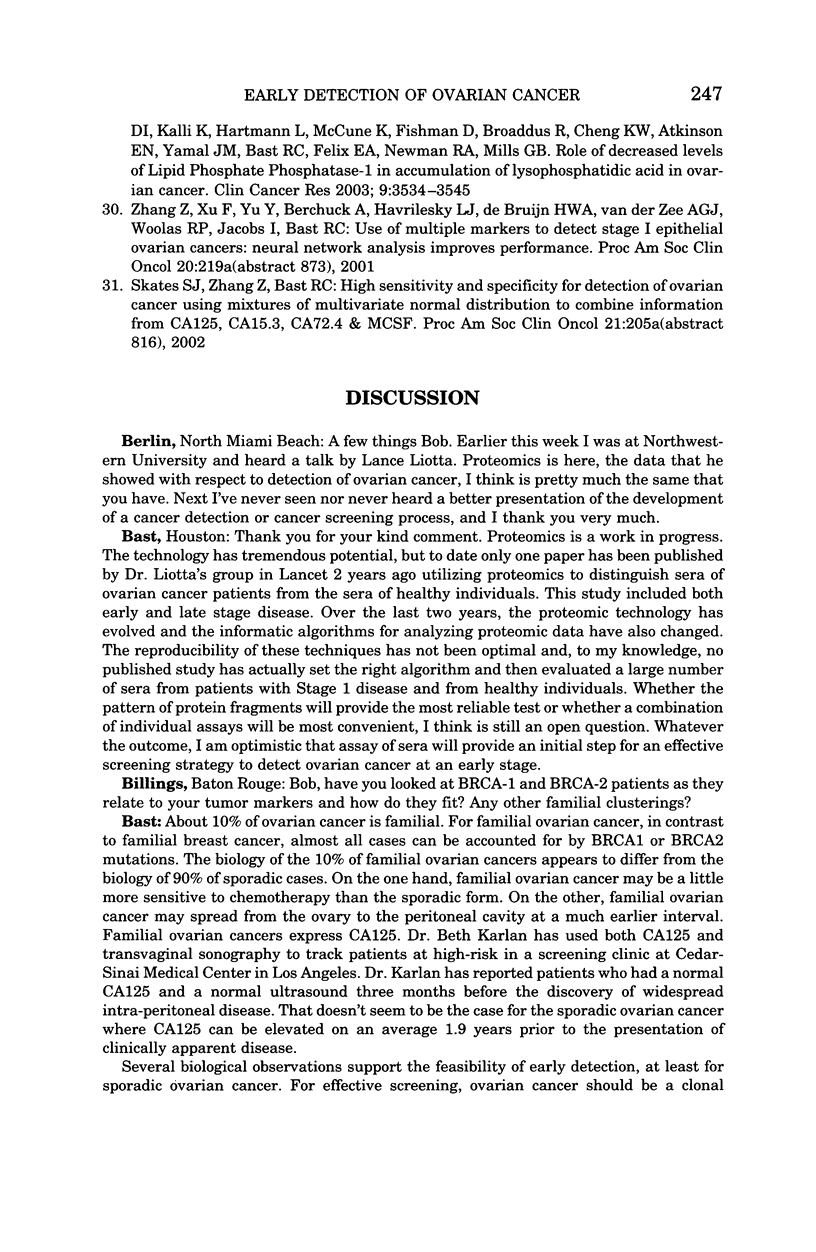
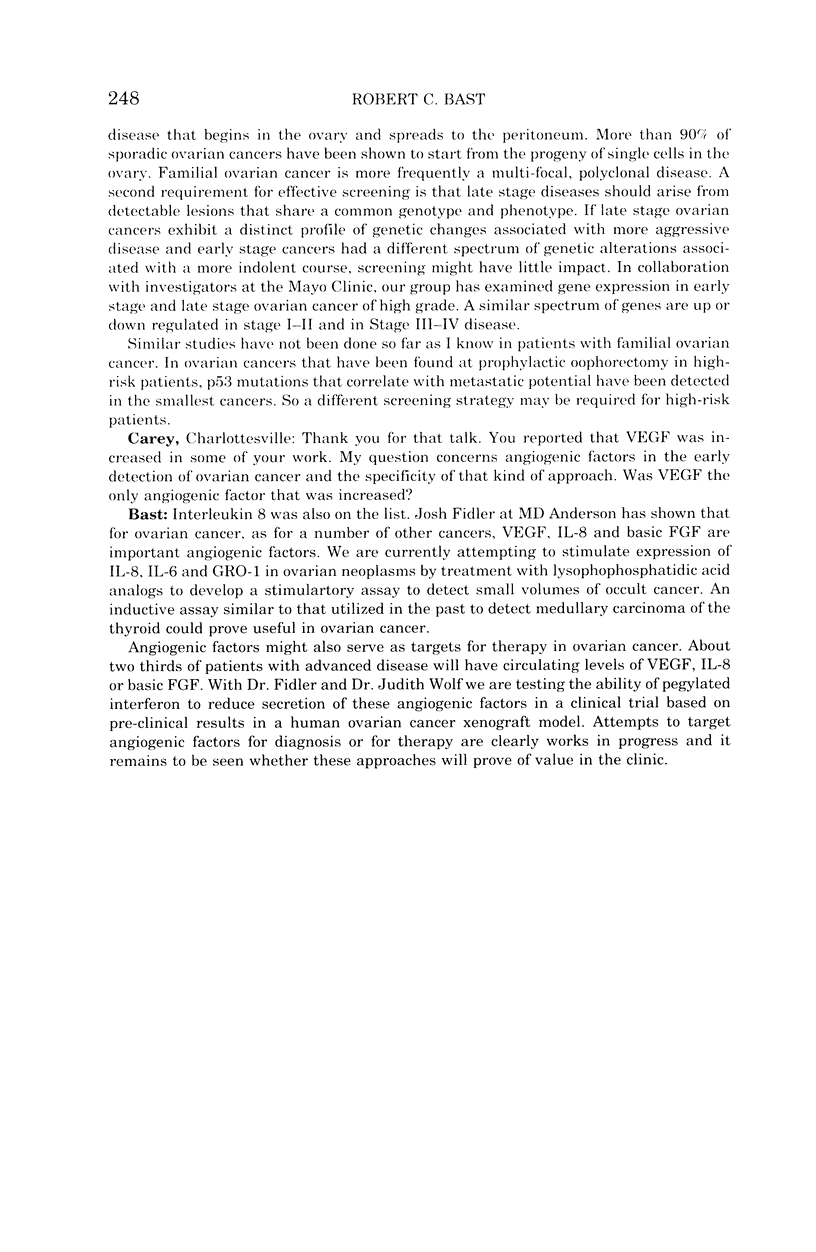
Images in this article
Selected References
These references are in PubMed. This may not be the complete list of references from this article.
- Bast R. C., Jr, Feeney M., Lazarus H., Nadler L. M., Colvin R. B., Knapp R. C. Reactivity of a monoclonal antibody with human ovarian carcinoma. J Clin Invest. 1981 Nov;68(5):1331–1337. doi: 10.1172/JCI110380. [DOI] [PMC free article] [PubMed] [Google Scholar]
- Bast R. C., Jr, Klug T. L., St John E., Jenison E., Niloff J. M., Lazarus H., Berkowitz R. S., Leavitt T., Griffiths C. T., Parker L. A radioimmunoassay using a monoclonal antibody to monitor the course of epithelial ovarian cancer. N Engl J Med. 1983 Oct 13;309(15):883–887. doi: 10.1056/NEJM198310133091503. [DOI] [PubMed] [Google Scholar]
- Bast R. C., Jr, Siegal F. P., Runowicz C., Klug T. L., Zurawski V. R., Jr, Schonholz D., Cohen C. J., Knapp R. C. Elevation of serum CA 125 prior to diagnosis of an epithelial ovarian carcinoma. Gynecol Oncol. 1985 Sep;22(1):115–120. doi: 10.1016/0090-8258(85)90015-0. [DOI] [PubMed] [Google Scholar]
- Bast Robert C., Jr, Urban Nicole, Shridhar Viji, Smith David, Zhang Zhen, Skates Steven, Lu Karen, Liu Jinsong, Fishman David, Mills Gordon. Early detection of ovarian cancer: promise and reality. Cancer Treat Res. 2002;107:61–97. doi: 10.1007/978-1-4757-3587-1_3. [DOI] [PubMed] [Google Scholar]
- Bourne T. H., Campbell S., Reynolds K. M., Whitehead M. I., Hampson J., Royston P., Crayford T. J., Collins W. P. Screening for early familial ovarian cancer with transvaginal ultrasonography and colour blood flow imaging. BMJ. 1993 Apr 17;306(6884):1025–1029. doi: 10.1136/bmj.306.6884.1025. [DOI] [PMC free article] [PubMed] [Google Scholar]
- Campbell S., Bhan V., Royston P., Whitehead M. I., Collins W. P. Transabdominal ultrasound screening for early ovarian cancer. BMJ. 1989 Dec 2;299(6712):1363–1367. doi: 10.1136/bmj.299.6712.1363. [DOI] [PMC free article] [PubMed] [Google Scholar]
- Hasholzner U., Baumgartner L., Stieber P., Meier W., Hofmann K., Fateh-Moghadam A. Significance of the tumour markers CA 125 II, CA 72-4, CASA and CYFRA 21-1 in ovarian carcinoma. Anticancer Res. 1994 Nov-Dec;14(6B):2743–2746. [PubMed] [Google Scholar]
- Jacobs I. J., Kohler M. F., Wiseman R. W., Marks J. R., Whitaker R., Kerns B. A., Humphrey P., Berchuck A., Ponder B. A., Bast R. C., Jr Clonal origin of epithelial ovarian carcinoma: analysis by loss of heterozygosity, p53 mutation, and X-chromosome inactivation. J Natl Cancer Inst. 1992 Dec 2;84(23):1793–1798. doi: 10.1093/jnci/84.23.1793. [DOI] [PubMed] [Google Scholar]
- Jacobs I., Bast R. C., Jr The CA 125 tumour-associated antigen: a review of the literature. Hum Reprod. 1989 Jan;4(1):1–12. doi: 10.1093/oxfordjournals.humrep.a136832. [DOI] [PubMed] [Google Scholar]
- Jacobs I., Bast R. C., Jr The CA 125 tumour-associated antigen: a review of the literature. Hum Reprod. 1989 Jan;4(1):1–12. doi: 10.1093/oxfordjournals.humrep.a136832. [DOI] [PubMed] [Google Scholar]
- Jacobs I., Stabile I., Bridges J., Kemsley P., Reynolds C., Grudzinskas J., Oram D. Multimodal approach to screening for ovarian cancer. Lancet. 1988 Feb 6;1(8580):268–271. doi: 10.1016/s0140-6736(88)90351-0. [DOI] [PubMed] [Google Scholar]
- Jemal Ahmedin, Murray Taylor, Samuels Alicia, Ghafoor Asma, Ward Elizabeth, Thun Michael J. Cancer statistics, 2003. CA Cancer J Clin. 2003 Jan-Feb;53(1):5–26. doi: 10.3322/canjclin.53.1.5. [DOI] [PubMed] [Google Scholar]
- Li S., Han H., Resnik E., Carcangiu M. L., Schwartz P. E., Yang-Feng T. L. Advanced ovarian carcinoma: molecular evidence of unifocal origin. Gynecol Oncol. 1993 Oct;51(1):21–25. doi: 10.1006/gyno.1993.1240. [DOI] [PubMed] [Google Scholar]
- Mok C. H., Tsao S. W., Knapp R. C., Fishbaugh P. M., Lau C. C. Unifocal origin of advanced human epithelial ovarian cancers. Cancer Res. 1992 Sep 15;52(18):5119–5122. [PubMed] [Google Scholar]
- Petricoin Emanuel F., Ardekani Ali M., Hitt Ben A., Levine Peter J., Fusaro Vincent A., Steinberg Seth M., Mills Gordon B., Simone Charles, Fishman David A., Kohn Elise C. Use of proteomic patterns in serum to identify ovarian cancer. Lancet. 2002 Feb 16;359(9306):572–577. doi: 10.1016/S0140-6736(02)07746-2. [DOI] [PubMed] [Google Scholar]
- Rosenthal A. N., Jacobs I. J. The role of CA 125 in screening for ovarian cancer. Int J Biol Markers. 1998 Oct-Dec;13(4):216–220. doi: 10.1177/172460089801300408. [DOI] [PubMed] [Google Scholar]
- Sato S., Yokoyama Y., Sakamoto T., Futagami M., Saito Y. Usefulness of mass screening for ovarian carcinoma using transvaginal ultrasonography. Cancer. 2000 Aug 1;89(3):582–588. doi: 10.1002/1097-0142(20000801)89:3<582::aid-cncr13>3.0.co;2-#. [DOI] [PubMed] [Google Scholar]
- Shridhar V., Lee J., Pandita A., Iturria S., Avula R., Staub J., Morrissey M., Calhoun E., Sen A., Kalli K. Genetic analysis of early- versus late-stage ovarian tumors. Cancer Res. 2001 Aug 1;61(15):5895–5904. [PubMed] [Google Scholar]
- Skates S. J., Xu F. J., Yu Y. H., Sjövall K., Einhorn N., Chang Y., Bast R. C., Jr, Knapp R. C. Toward an optimal algorithm for ovarian cancer screening with longitudinal tumor markers. Cancer. 1995 Nov 15;76(10 Suppl):2004–2010. doi: 10.1002/1097-0142(19951115)76:10+<2004::aid-cncr2820761317>3.0.co;2-g. [DOI] [PubMed] [Google Scholar]
- Tanyi Janos L., Hasegawa Yutaka, Lapushin Ruth, Morris Andrew J., Wolf Judith K., Berchuck Andrew, Lu Karen, Smith David I., Kalli Kimberly, Hartmann Lynn C. Role of decreased levels of lipid phosphate phosphatase-1 in accumulation of lysophosphatidic acid in ovarian cancer. Clin Cancer Res. 2003 Sep 1;9(10 Pt 1):3534–3545. [PubMed] [Google Scholar]
- Xu Y., Shen Z., Wiper D. W., Wu M., Morton R. E., Elson P., Kennedy A. W., Belinson J., Markman M., Casey G. Lysophosphatidic acid as a potential biomarker for ovarian and other gynecologic cancers. JAMA. 1998 Aug 26;280(8):719–723. doi: 10.1001/jama.280.8.719. [DOI] [PubMed] [Google Scholar]
- Zurawski V. R., Jr, Orjaseter H., Andersen A., Jellum E. Elevated serum CA 125 levels prior to diagnosis of ovarian neoplasia: relevance for early detection of ovarian cancer. Int J Cancer. 1988 Nov 15;42(5):677–680. doi: 10.1002/ijc.2910420507. [DOI] [PubMed] [Google Scholar]
- van Nagell J. R., Jr, DePriest P. D., Reedy M. B., Gallion H. H., Ueland F. R., Pavlik E. J., Kryscio R. J. The efficacy of transvaginal sonographic screening in asymptomatic women at risk for ovarian cancer. Gynecol Oncol. 2000 Jun;77(3):350–356. doi: 10.1006/gyno.2000.5816. [DOI] [PubMed] [Google Scholar]





